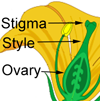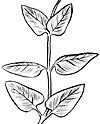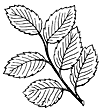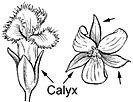Keahi
Sideroxylon polynesicum
Bully family (Sapotaceae)
Native species (indigenous)
This small tree of dry lowland forests, with milky sap and many dark purple or brown like olives, is recognized also by the rusty brown hairs of young foliage, lower leaf surfaces, twigs, and flowers.
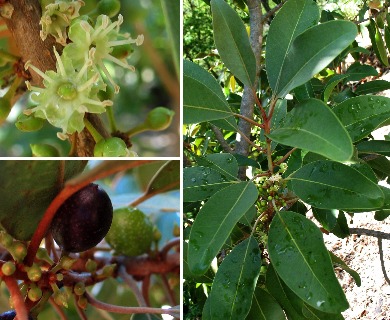
©2008 David Eickhoff
Leaves scattered along twigs, with slender leaf-stalks mostly 3⁄4–1 1⁄4 inches (2–3 ) long. Blades elliptical, 1 1⁄4–3 1⁄4 inches (3–8 ) long and 3⁄4–2 inches (2–5 ) wide, blunt or rounded at both ends, turned under at edges, thick and leathery, upper surface shiny green and hairless, lower surface with pressed rusty brown hairs and often becoming nearly hairless in age.
Flowers many, 1–5 at leaf base or on twig back of leaves on stalks of 1⁄4 inch (6 ), rusty hairy, fragrant, 3⁄16 inch (5 ) long and wide, composed of hairy with usually 4–5 (3–6) overlapping pointed urn-shaped greenish white hairless with short tube usually 7–9 (5–12) pointed, rounded, or usually 7–9 (5–12) small inserted on base of and and with elliptical hairy of usually 3–5 (2–6) cells, one ovule in each cell, short stout and dot
(berries) elliptical, many along twigs 1⁄4–5⁄8 inch (12–15 ) long and 3⁄8 inch (10 ) wide, shiny dark purple or brown, with and base and pointed at with thin flesh, not edible. Seed single, elliptical or rounded, 5⁄16 inch (8 ) long, shiny brown, with large rounded scar at base. many, from May to September.
The hard durable wood apparently has not been used.
Scattered in dry forests through the Hawaiian Islands at 400–2000 ft (122–610 ) altitude. Formerly common, now rare.
Special area
Wahiawa
Range
Oahu, Molokai, Maui, Hawaii; also Raivavae, Rapa in South Pacific
Botanical
Nesoluma polynesicum (Hillebr.) Baill., Chrysophyllum polynesicum Hillebr.
This variable species has several named forms generally not distinguished.

